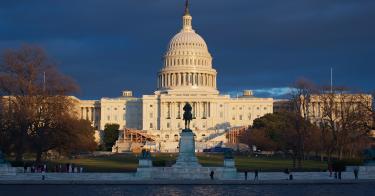One of the big unfinished items on this year’s Congressional agenda is financial regulatory reform.
The House passed the Financial CHOICE Act, a major financial reform bill in June. But the Senate has yet to offer a companion bill, and it is pretty much gospel that Democrats won’t support anything that undoes Dodd-Frank.
The reform effort is not dead, however, because Senate Republicans can still pass key policies in the CHOICE Act, with only the 52-seat majority they currently hold, through the budget reconciliation process.
Senate rules make reconciliation a tricky undertaking, but Senators in the majority party have used reconciliation many times to enact all sorts of policies. Here are just a few instances:
- a 1985 reconciliation bill mandated a health insurance program, known as COBRA, to give some employees access to continued coverage after leaving a job;
- a 1986 reconciliation bill ordered the sale of the government-owned Conrail railroad corporation;
- a 1996 reconciliation bill required able-bodied welfare recipients to seek or be trained for work;
- a 2010 reconciliation bill established Obamacare and a government takeover of student loans.
Under Senate rules, a reconciliation bill is not subject to filibuster as long as its subject matter is restricted exclusively to items that directly affect the budget. And any senator may invoke the Byrd rule to challenge provisions of a reconciliation bill that have nothing to do with spending, taxes, the debt limit, or deficit reduction.
Given this rule, it’s unlikely that the Senate can pass the entire CHOICE Act through reconciliation. But all is not lost.
The nonpartisan Congressional Budget Office (CBO) recently estimated “that enacting the legislation [the CHOICE Act] would reduce federal deficits by $24.1 billion over the 2017-2027 period.” Most of these budgetary savings come from two key CHOICE Act reforms: restructuring the Consumer Financial Protection Bureau (CFPB); and, replacing Title II of Dodd-Frank, known as orderly liquidation authority (OLA), with a bankruptcy provision.
There are rumblings on Capitol Hill that even these two provisions won’t pass the Byrd rule test, but history suggests that there are no real procedural hurdles.
In general, the Byrd rule allows any senator to raise a point of order to strike extraneous matter from the bill. According to the Congressional Research Service:
Subsection (b)(1) of the Byrd rule provides definitions of what constitutes extraneous matter for purposes of the rule. The Senate Budget Committee, in its report on the budget resolution for FY1994, noted “‘Extraneous’ is a term of art. Broadly speaking, the rule prohibits inclusion in reconciliation of matter unrelated to the deficit reduction goals of the reconciliation process.”
The Congressional Research Service also notes that, under the Byrd rule, a provision is considered extraneous if it meets at least one of six tests. Of the six, only one is ambiguous enough that it could possibly present a problem for financial regulation reform. An opponent could conceivably argue that the budgetary impact of CFPB and OLA provisions are “merely incidental.”
It’s unlikely that such an argument would prevail for the CFPB provisions because Dodd-Frank created the CFPB with a special off-budget funding mechanism. The CHOICE Act restructures the Bureau and puts it through the regular appropriations process.
The OLA provisions also appear to be a slam-dunk, because CHOICE eliminates the orderly liquidation fund, the core of Title II of Dodd-Frank.
In an orderly liquidation under Title II, the Federal Deposit Insurance Corporation (FDIC) acts as the receiver of the failing firm’s parent holding company. The FDIC transfers the parent’s assets, derivatives, and short-term obligations to a newly created “bridge” company, and the bridge is exempt from paying all federal, state, and local taxes.
The bridge company also recapitalizes the subsidiaries if the FDIC deems it necessary.
Theoretically, these actions could be supported through private borrowing, but the bridge company can be supported by the orderly liquidation fund. This fund is analogous to the FDIC deposit insurance fund; it contains the proceeds of obligations issued by the FDIC and purchased by the Treasury Secretary. In other words, taxpayers are ultimately responsible for the fund.
There is also very clear historical precedent for eliminating – and creating – federal “funds” through the reconciliation process. Among them:
- The Deficit Reduction Act of 2005. This law terminated funding for the Watershed Rehabilitation Program and five rural development programs. It also established the Digital Television Transition and Public Safety Fund, and merged the Bank Insurance Fund and the Savings Association Insurance Fund into the FDIC’s Deposit Insurance Fund.
- The Taxpayer Refund and Relief Act of 1999 (vetoed by the President). This Act would have created an Environmental Remediation Trust Fund in the U.S. Treasury.
- The Balanced Budget Act of 1997. This law established the District of Columbia Federal Pension Liability Trust Fund.
- The Personal Responsibility and Work Opportunity Reconciliation Action of 1996. Aside from implementing work requirements on certain welfare benefits, this law established the Contingency Fund for State Welfare Programs.
Overall, there is no compelling rules-based reason that the Senate cannot, at the very least, implement two major CHOICE Act reforms – restructuring the CFPB and replacing OLA with bankruptcy – via the reconciliation process.
It is also obvious that the Trump administration is willing to sign a reform package based on the CHOICE Act. The White House’s statement of administration policy is crystal clear:
The Administration thanks Chairman Jeb Hensarling for his leadership on the important issues addressed by the Financial CHOICE Act. The Administration supports passage of the substitute amendment to H.R. 10 as a necessary and important step in moving financial reform legislation through the Congress. Upon passage, the Administration looks forward to working with the Senate on arriving at a final piece of legislation.
So now it’s up to the Senate to deliver on financial regulatory reform that actually fixes the problems that brought on the 2008 financial crisis.
This piece originally appeared in Forbes


